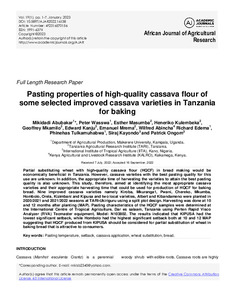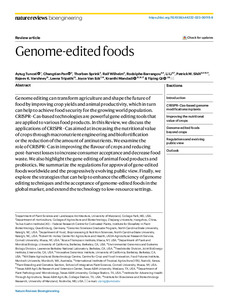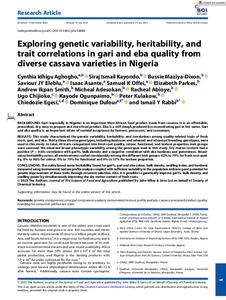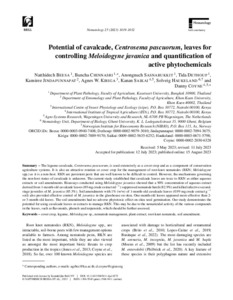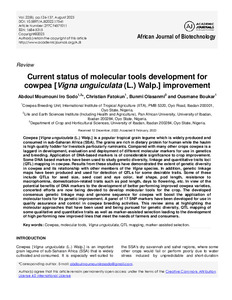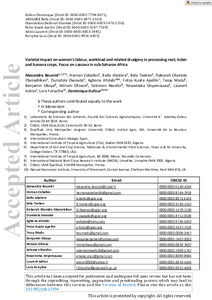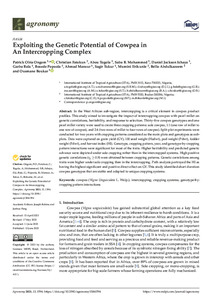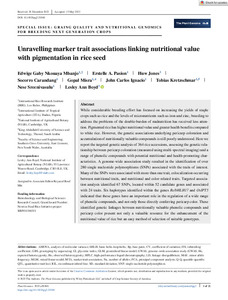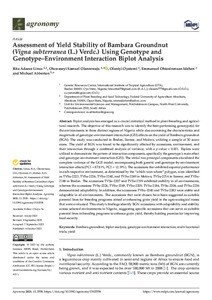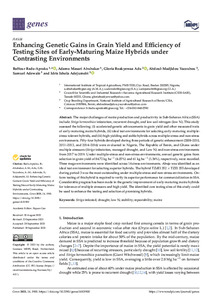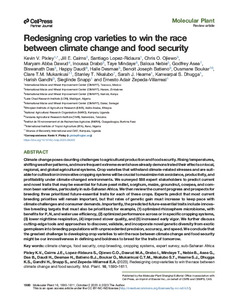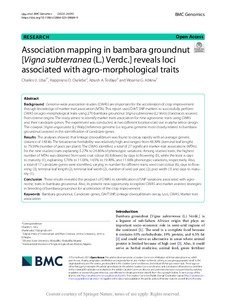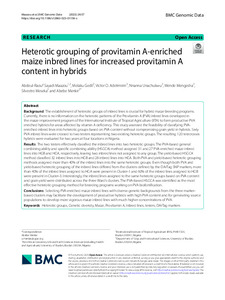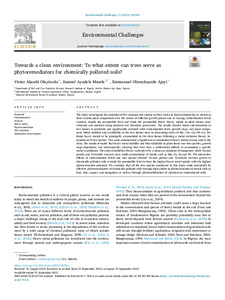Welcome to the International Institute of Tropical Agriculture Research Repository
Journal and Journal Articles: Recent submissions
Now showing items 221-240 of 5283
-
Pasting properties of high-quality cassava flour of some selected improved cassava varieties in Tanzania for baking
(2023-01-31)Partial substituting wheat with high-quality cassava flour (HQCF) in bread making would be economically beneficial in Tanzania. However, cassava varieties with the best pasting quality for this use are unknown. In addition, the appropriate time of harvesting the varieties to attain the best pasting quality is also unknown. This study, therefore, aimed at identifying the most appropriate cassava varieties and their appropriate harvesting time that could be used for production of HQCF for baking ... -
Genome-edited foods
(2023-10-04)Genome editing can transform agriculture and shape the future of food by improving crop yields and animal productivity, which in turn can help to achieve food security for the growing world population. CRISPR–Cas-based technologies are powerful gene editing tools that are applied to various food products. In this Review, we discuss the applications of CRISPR–Cas aimed at increasing the nutritional value of crops through macronutrient engineering and biofortification or the reduction of the amount ... -
Exploring genetic variability, heritability, and trait correlations in gari and eba quality from diverse cassava varieties in Nigeria
(2023-07)BACKGROUND Gari (especially in Nigeria) is an important West African food product made from cassava. It is an affordable, precooked, dry, easy to prepare and store food product. Eba is a stiff dough produced by reconstituting gari in hot water. Gari and eba quality is an important driver of varietal acceptance by farmers, processors, and consumers. RESULTS This study characterized the genetic variability, heritability, and correlations among quality-related traits of fresh roots, gari, and eba. ... -
Potential of cavalcade, Centrosema pascuorum, leaves for controlling Meloidogyne javanica and quantification of active phytochemicals
(2023-08-15)The legume cavalcade, Centrosema pascuorum, is used extensively as a cover crop and as a component of conservation agriculture systems. It is also an attractive rotation or cover crop for the management of root-knot nematodes (RKN; Meloidogyne spp.) as it is a non-host. RKN are persistent pests that are well known to be difficult to control. However, the mechanisms governing the non-host status of cavalcade is unknown. The current study established that cavalcade leaves are toxic to RKN as either ... -
Current status of molecular tools development for cowpea [Vigna unguiculata (L.) Walp.] improvement
(2023-08)Cowpea [Vigna unguiculata (L.) Walp.] is a popular tropical grain legume which is widely produced and consumed in sub-Saharan Africa (SSA). The grains are rich in dietary protein for human while the haulm is high quality fodder for livestock particularly ruminants. Compared with many other crops cowpea is a laggard in development, evaluation and deployment of different molecular markers for use in genetics and breeding. Application of DNA-based markers is of considerable significance to crop ... -
Varietal impact on women's labour, workload and related drudgery in processing root, tuber and banana crops. Focus on cassava in sub-Saharan Africa
(2023-08-22)Roots, tubers and cooking bananas are bulky and highly perishable. In Africa, except for yams, their consumption is mainly after transport, peeling and cooking in the form of boiled pieces or dough, a few days after harvest. To stabilize, better preserve the products and, in the case of cassava, release toxic cyanogenic glucosides, a range of intermediate products have been developed, mainly for cassava, related to fermentation and drying after numerous processing operations. This review highlights, ... -
Exploiting the genetic potential of cowpea in an intercropping complex
(2023)In the West African sub-region, intercropping is a critical element in cowpea product profiles. This study aimed to investigate the impact of intercropping cowpea with pearl millet on genetic correlations, heritability, and response to selection. Thirty-five cowpea genotypes and one pearl millet variety were used to create three cropping patterns: sole cowpea, 1:1 (one row of millet to one row of cowpea), and 2:4 (two rows of millet to four rows of cowpea). Split-plot experiments were conducted ... -
Recent advances in cowpea IPM in West Africa
(2023)Cowpea is an important and climate-resilient grain legume for human and livestock nutrition worldwide. Its grains represent a valuable source of protein for rural families in Sub-Saharan Africa while its haulms offer nutritious fodder for livestock, especially, in the Sahel regions. Cowpea production, unfortunately, faces substantial challenges of field and storage insect pests which can cause up to 100% losses. The use of synthetic pesticides, although providing farmers with a good level of pest ... -
Exploring phenotypic variation of diverse bambara groundnut (Vigna subterranea L) origin and development of mini-core collection for future breeding
(2023-04-12)Understanding the phenotypic variation and designing a mini-core collection is an efficient method to accelerate the genetic gain of bambara groundnut. A collection of 300 bambara groundnut landraces from 25 different countries of origin sourced from gene banks were used to analyze phenotypic variability among the landraces and develop a mini-core collection for future breeding. The landraces were evaluated in alpha lattice design with two replications for 2 years (2019 and 2020). The results ... -
Unravelling marker trait associations linking nutritional value with pigmentation in rice seed
(2023)While considerable breeding effort has focused on increasing the yields of staple crops such as rice and the levels of micronutrients such as iron and zinc, breeding to address the problems of the double-burden of malnutrition has received less attention. Pigmented rice has higher nutritional value and greater health benefits compared to white rice. However, the genetic associations underlying pericarp coloration and accumulation of nutritionally valuable compounds is still poorly understood. Here ... -
The combining ability of extra-early maturing quality protein maize (Zea mays) inbred lines and the performance of their hybrids in Striga-infested and low-nitrogen environments
(2023-10-10)Maize production in sub-Saharan Africa (SSA) faces challenges due to the damage caused by the parasitic weed, Striga hermonthica (Del.) Benths and low soil nitrogen. To address these constraints and improve food security and nutrition, this study assessed the combining ability of 47 inbred lines and four testers, grouped them into heterotic groups, identified effective testers, and determined the stability of the lines in hybrid combinations under contrasting research conditions. The study was ... -
Assessment of yield stability of bambara groundnut (Vigna subterranea (L.) Verdc.) using genotype and genotype-environment interaction biplot analysis
(2023-10-04)Biplot analysis has emerged as a crucial statistical method in plant breeding and agricultural research. The objective of this research was to identify the best-performing genotype(s) for the environments in three distinct regions of Nigeria while also examining the characteristics and magnitude of genotype–environment interaction (GEI) effects on the yield of Bambara groundnut (BGN). The study was conducted in Ibadan, Ikenne, and Mokwa, utilizing a sample of 30 accessions. The yield of BGN was ... -
Enhancing genetic gains in grain yield and efficiency of testing sites of early-maturing maize hybrids under contrasting environments
(2023-09-30)The major challenges of maize production and productivity in Sub-Saharan Africa (SSA) include Striga hermonthica infestation, recurrent drought, and low soil nitrogen (low N). This study assessed the following: (i) accelerated genetic advancements in grain yield and other measured traits of early-maturing maize hybrids, (ii) ideal test environments for selecting early-maturing multiple-stress tolerant hybrids, and (iii) high-yielding and stable hybrids across multiple-stress and non-stress ... -
Genetic structure analysis and identifying key founder inbred lines in diverse elite sub‑tropical maize inbred lines
(2023-07-20)Understanding the genetic relationships between the key founder inbred lines and derived inbred lines could provide insight into the breeding history and the structure of genetic diversity of the available elite inbred lines with desirable target traits. The maize improvement program at the International Institute of Tropical Agriculture (IITA) analyzed the pedigree information of 623 sub-tropical maize inbred lines generated at the IITA maize breeding program to identify the key founder inbred ... -
Redesigning crop varieties to win the race between climate change and food security
(2023-10)Climate change poses daunting challenges to agricultural production and food security. Rising temperatures, shiftingweatherpatterns,andmore frequent extremeeventshave alreadydemonstratedtheir effectsonlocal, regional, and global agricultural systems. Crop varieties thatwithstand climate-related stresses and are suitable for cultivation in innovative croppingsystemswillbe crucial tomaximize risk avoidance, productivity, and profitability under climate-changed environments. We surveyed 588 expert ... -
Cutting dipping application of Flupyradifurone against cassava whiteflies Bemisia tabaci and impact on its parasitism in cassava
(2023-09-30)The cassava whitefly Bemisia tabaci causes damage in cassava through the feeding and vectoring of plant viruses that cause cassava mosaic and cassava brown streak diseases. This study sought to explore the efficacy of cutting dipping in flupyradifurone for whitefly control and the impact of the mode of application on whitefly parasitism under farmer field conditions. The insecticide treatment significantly reduced adult whiteflies by 41%, nymphs by 64%, and cassava mosaic disease (CMD) incidence ... -
Association mapping in bambara groundnut [Vigna subterranea (L.) Verdc.] reveals loci associated with agro-morphological traits
(2023-10-06)Background Genome-wide association studies (GWAS) are important for the acceleration of crop improvement through knowledge of marker-trait association (MTA). This report used DArT SNP markers to successfully perform GWAS on agro-morphological traits using 270 bambara groundnut [Vigna subterranea (L.) Verdc.] landraces sourced from diverse origins. The study aimed to identify marker traits association for nine agronomic traits using GWAS and their candidate genes. The experiment was conducted at ... -
Heterotic grouping of provitamin A-enriched maize inbred lines for increased provitamin A content in hybrids
(2023-09-27)Background The establishment of heterotic groups of inbred lines is crucial for hybrid maize breeding programs. Currently, there is no information on the heterotic patterns of the Provitamin A (PVA) inbred lines developed in the maize improvement program of the International Institute of Tropical Agriculture (IITA) to form productive PVA enriched hybrids for areas affected by vitamin A deficiency. This study assessed the feasibility of classifying PVA-enriched inbred lines into heterotic groups ... -
Towards a clean environment: to what extent can trees serve as phytoremediators for chemically polluted soils?
(2023)The study investigated the potential of five common tree species in West Africa to bioaccumulate heavy metals in their various plant components over the course of different growth phases and at varying contamination levels (control, double the permissible level and triple the permissible limit). Heavy metals in plant tissues were extracted and analyzed using standard wet chemistry procedures. The results showed metal concentrations in tree tissues to positively and significantly correlate with ... -
Scale up trials to validate modified crops' benefits
(2023-09-21)

